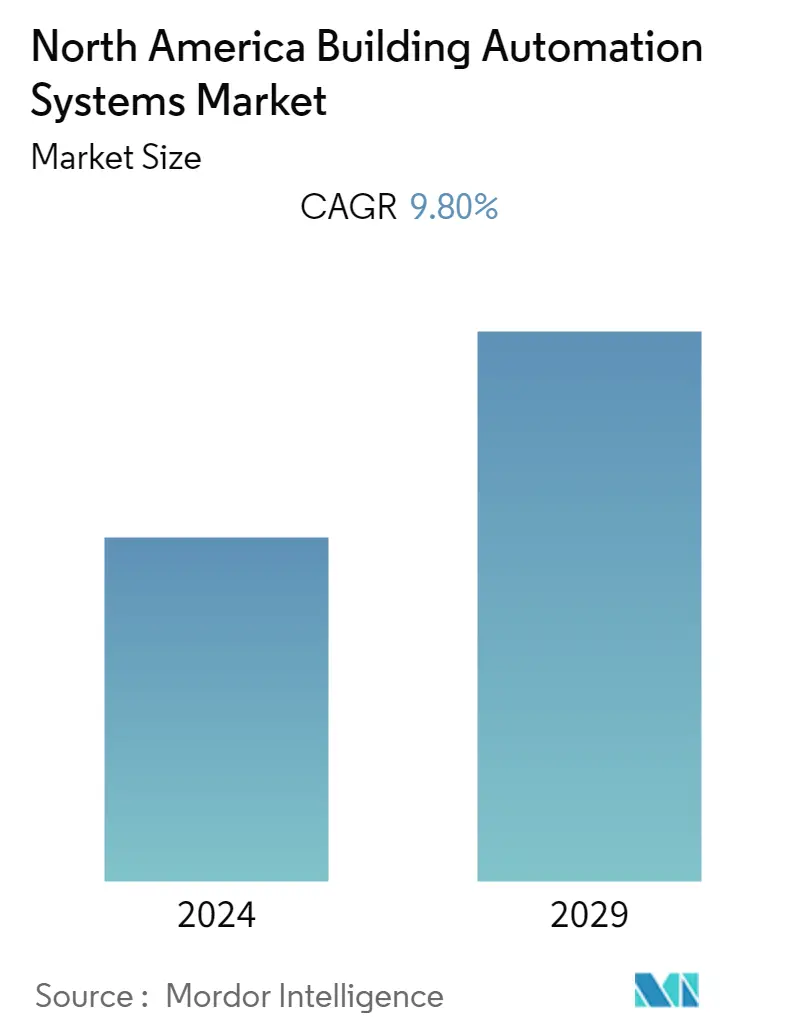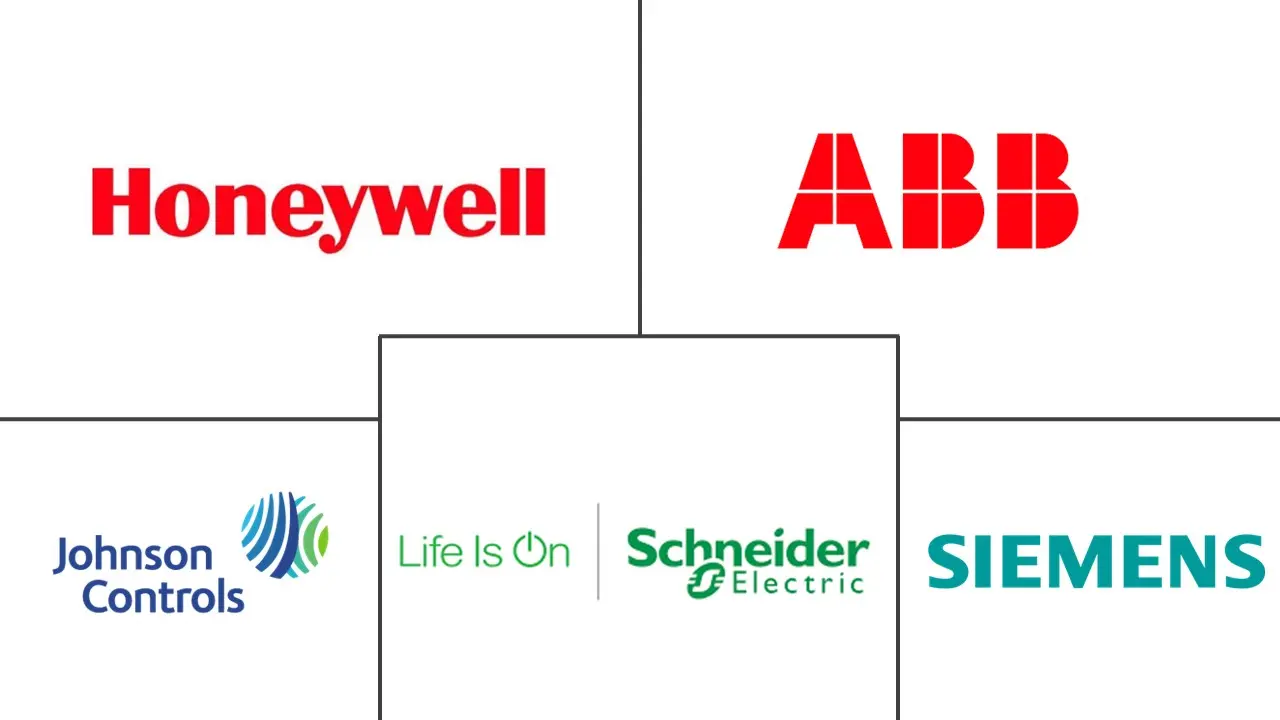Market Size of North America Building Automation Systems Industry

| Study Period | 2019 - 2029 |
| Base Year For Estimation | 2023 |
| Forecast Data Period | 2024 - 2029 |
| Historical Data Period | 2019 - 2022 |
| CAGR (2024 - 2029) | 9.80 % |
| Market Concentration | Medium |
Major Players
*Disclaimer: Major Players sorted in no particular order |
North America Building Automation Systems Market Analysis
The North America Building Automation Systems Market is expected to register a CAGR of 9.80% during the forecast period(2024-2029).
A building automation system (BAS), also referred to as a building control system or a building management system, is a system that controls several electric, electronic, and mechanical systems throughout a building. Components like building management systems, lighting controls, fire detection, HVAC controls, and security systems are included in the scope of the study and span across end-users like residential, commercial, and industrial.
- Owing to an increasing number of commercial buildings, the growing demand for reductions in energy consumption levels and the continuing growth of energy usage created a need to develop innovative techniques to reduce and optimize building energy use in North America. Moreover, building energy management systems (BEMS) have gained popularity because of the increasing interest in energy conservation and savings. Building energy management systems can control and monitor the building's energy needs.
- Reducing energy consumption has been a primary concern among commercial building owners and managers to save money. According to the US Energy Information Administration, almost 40% of the energy consumed in the country powers commercial and residential buildings. According to the New York State Energy Research and Development Authority (NYSERDA), enabling real-time energy management systems and smart technologies can reduce costs by an average of 15%. Such developments have been influencing the demand for EMS as part of smart solutions in both commercial and residential buildings.
- Moreover, according to the US Department of Energy, the building sector accounted for about 76% of the electricity used, resulting in a considerable amount of associated greenhouse gas (GHG) emissions, thereby making it necessary to reduce energy consumption in buildings to comply with the national energy and environmental challenges and decrease costs to building owners and tenants.
- Furthermore, according to NRCan, in Canada, over 81% of emissions come from energy. Canadians use more energy because of extreme temperatures, a vast landscape, and a dispersed population. The challenges of transitioning to a lower-carbon energy system are numerous. Still, they also present opportunities for Canada to be a global leader by supporting innovative technologies in the power and energy sector, including promoting growing renewables and cleantech sectors and consequently fueling the market.
- The share of fossil fuel use in the building sector's energy demand decreased slightly to around 36%. Furthermore, following these efforts toward executing the SDS initiative, the building sector's CO2 emissions were expected to drop to 8.852 GtCO2 by the end of 2020.
- Technology for building automation systems (BAS) has advanced significantly and is always improving with new capabilities. It is noteworthy that many building managers still manually operate HVAC systems because they have little faith in the building automation system. Due to ignorance or improper configuration of the building automation system by the installation contractors, far too many buildings with perfectly functional building automation systems still have their equipment run manually by the building operators.
- With the COVID-19 outbreak, most commercial and industrial construction projects started at a slow pace, while some were canceled. Production lines at some HVAC manufacturers had to be put on hold for several weeks, and installers saw their new installation projects limited by sanitary guidelines. However, after the pandemic, commercial and industrial construction projects started, which propelled market growth.
North America Building Automation Systems Industry Segmentation
Building automation systems exhibit functions such as control of the building's environment, operating systems depending on energy demand, and monitoring system performance, based on which the systems produce sound alerts as required. Moreover, it centrally controls the building's heating, ventilation, and air conditioning (HVAC), electrical, lighting, shading, access control, security systems, and other interrelated systems.
The North America building automation systems market is segmented by components (hardware [controllers, field devices, and other components], software, and services), end-user (residential, commercial, and industrial), and by country (United States and Canada). The market sizes and forecasts are provided in terms of value in USD for all the above segments.
| By Component | |||||
| |||||
| Software | |||||
| Services |
| By End-user | |
| Residential | |
| Commercial | |
| Industrial |
| By Country | |
| United States | |
| Canada |
North America Building Automation Systems Market Size Summary
The North America Building Automation Systems Market is poised for significant growth, driven by the increasing need for energy efficiency and smart building solutions across residential, commercial, and industrial sectors. Building automation systems, which encompass various components such as HVAC controls, lighting, fire detection, and security systems, are becoming essential as the region faces rising energy costs and environmental concerns. The demand for energy management systems is particularly strong, as these systems help monitor and optimize energy use, aligning with national goals to reduce greenhouse gas emissions and energy consumption. The market is also benefiting from advancements in technology, with IoT-enabled solutions gaining traction for their ability to enhance building safety and efficiency.
The market landscape is characterized by a mix of established players and innovative startups, with companies like Johnson Control International, Honeywell International, Siemens AG, and Schneider Electric SE leading the charge. Government initiatives in the United States and Canada further bolster market growth, with investments in energy-efficient technologies and programs aimed at reducing emissions and promoting sustainability. The COVID-19 pandemic initially slowed down construction projects, but the subsequent recovery has spurred demand for smart building solutions. As the region continues to prioritize energy conservation and smart infrastructure, the building automation systems market is expected to expand, offering lucrative opportunities for stakeholders.
North America Building Automation Systems Market Size - Table of Contents
-
1. MARKET INSIGHTS
-
1.1 Market Overview
-
1.2 Industry Attractiveness - Porter's Five Forces Analysis
-
1.2.1 Bargaining Power of Suppliers
-
1.2.2 Bargaining Power of Consumers
-
1.2.3 Threat of New Entrants
-
1.2.4 Threat of Substitutes
-
1.2.5 Intensity of Competitive Rivalry
-
-
1.3 Industry Value Chain Analysis
-
-
2. MARKET SEGMENTATION
-
2.1 By Component
-
2.1.1 Hardware
-
2.1.1.1 Controllers
-
2.1.1.2 Field Devices
-
2.1.1.3 Other Components
-
-
2.1.2 Software
-
2.1.3 Services
-
-
2.2 By End-user
-
2.2.1 Residential
-
2.2.2 Commercial
-
2.2.3 Industrial
-
-
2.3 By Country
-
2.3.1 United States
-
2.3.2 Canada
-
-
North America Building Automation Systems Market Size FAQs
What is the current North America Building Automation Systems Market size?
The North America Building Automation Systems Market is projected to register a CAGR of 9.80% during the forecast period (2024-2029)
Who are the key players in North America Building Automation Systems Market?
Honeywell International Inc., Johnson Control International PLC, Siemens AG, Schneider Electric SE and Oracle Corporation are the major companies operating in the North America Building Automation Systems Market.

